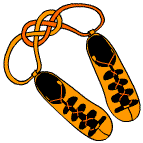Irish Dancing
Created | Updated Aug 4, 2006

An Introduction to Step Dancing - The Ancient Art of the Celts
Irish Step Dancing is from, well of course, Ireland. But not just Ireland, because the entire Celtic culture has contributed. Step dancing started off as mostly party dancing, but has evolved into very complex competition dancing.
The Categories
Irish Dancing is done in two categories:
The Dances
There are four basic dances in soft shoe:
- The Reel - reels are dances in 2/4 time and the beat can vary from moderately fast to fast. The reels one does by oneself usually travel all around the floor and take up a lot of space, having leaps of some sort in each step so you go very far with each beat. Reels can also be done in hard shoe, these varieties having less leaps. The reels one does in groups are also known as figure dances, although not all figure dances are reels. These are done with two or more people, and look a lot like American square dances. They are most often done at social functions and are easy to learn.
- The Light Jig - Jigs are usually the first dance learned. They are in 6/8 time and are always done individually. Light jigs or soft shoe jigs are usually simple but elegant dances. Even the first step to a non-dancer looks complicated, but it is easily learned.
- The Single Jig - also done in 6/8 time.
- The Slip Jig - a Slip Jig is done in 9/8 time. That's three sets of three triplets per bar. It's a very light and soft dance, for women only, which is difficult to learn but a joy once you know it.
There are also figure dances in soft shoe; this is where several people dance together, with intricate hand movements. Figure dances are mostly done at shows and parties.
There are a myriad of dances in hard shoe. The first hard shoe dance a person learns is called St Patrick's Day.
Believe it or not, Irish Dancing is growing. A Feis1 is held at least once a month. There are more and more Irish Dance Schools emerging too. Shows like Riverdance, and Lord of the Dance have spread the awareness of Irish Dancing across the globe. Incidentally, Michael Flatley, creator of Riverdance and Lord of the Dance and star dancer of Lord of the Dance is the world's fastest dancer, with 34 separate taps of his foot a second while dancing.
The Costumes
Contrary to popular belief, Irish Dancers do not wear Kilts, unless they are extremely small. The dancers, that is, not the kilts. Each dance school has its own distinct costume. The boys usually wear the same costume no matter what level, while the girls have a distinct but simple costume for beginners, and a distinct, expensive, and beautiful costume for advanced dancers. All the costume designs come from the Book of Kells, which is an ancient, hand-written, and beautifully engraved Bible. The Book of Kells is on display in Ireland.
Irish Dance Hierarchy
Irish Dancing is very organised, controlled by the World Wide Irish Dancing Committee. A point of interest: dancing competitions cannot be videotaped, because every school has its own variation of the dances -except the traditional St Patrick's Day - and all are copyrighted.
Competitions
There are seven normal levels in competition:
You compete in every dance separately; that is, you can have a different ranking in each dance and must advance in each one individually. Competitions are judged by certified judges. All the music at a Feis is live; it is usually an accordian/keyboard accompaniment.
All In All
Irish Dancing is great fun and very fulfilling. You can learn about an ancient culture and make some new friends.
Bear in mind that you can't just enter a competition even if you know some Irish Dancing, you have to be an registered and active member of and Irish Dance school. There are plenty.

